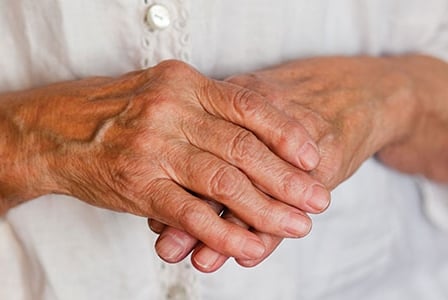
There are more than 100 types of arthritis. We compare two of the most common: osteoarthritis and rheumatoid arthritis.
When most people hear the word “arthritis” they think of osteoarthritis, the most common type that classically affects older people. There are actually more than 100 different types of arthritis which affect the joints differently and have different causes.
Here is a primer on two of the most common types of arthritis: osteoarthritis (OA) and rheumatoid arthritis (RA).
Do both OA and RA begin later in life?
Osteoarthritis
OA affects one in 10 Canadian adults and affects men and women equally past the age of 60. Men are more likely to get early-onset OA. Seventy percent of people over the age of 70 have signs of OA on x-ray, though not all people with x-ray signs of OA experience symptoms.
Rheumatoid arthritis
One out of every 100 Canadians suffers from RA. It can begin at any time in life, but most commonly appears in people between 25 and 50 years of age.
What are the risk factors?
Osteoarthritis
Being overweight puts excess stress on the joints and can increase the likelihood of developing OA. Family history of OA is also a risk factor, particularly for the type of OA that develops in the small joints of the hand.
Rheumatoid arthritis
Women are much more likely to develop RA, though it can also occur in men and even children. Genetic predisposition may also play a role, as a family history of RA slightly increases risk for other family members .
Do both RA and OA have a similar underlying cause?
Osteoarthritis
OA is primarily caused by the wear and tear of aging. That said, normal activity and exercise are good for joints and don’t necessarily cause OA, so don’t avoid regular activities in an attempt to avoid developing arthritis. Injury to a joint and repetitive, excessive use of certain joints can also lead to OA.
Rheumatoid arthritis
RA is a type of inflammatory, autoimmune arthritis. After a triggering event (which is often unknown), the body’s immune system starts to make antibodies against itself. These antibodies attack the joints and other parts of the body, causing painful inflammation, swelling, and eventual destruction of the related joints.
What actually happens in the joints?
Osteoarthritis
In OA, the joint cartilage, which normally acts as a cushion between the bones, breaks down over time and is gradually lost. The bones of the joint may begin to rub against each other and cause pain.
Rheumatoid arthritis
In RA, the synovial membrane that normally lubricates and protects the joint becomes inflamed by the attacking antibodies. The inflammation becomes chronic and with time can deform and destroy the joint.
Do OA and RA affect different joints and progress in different patterns?
Osteoarthritis
OA develops gradually in many different joints. It commonly affects the fingers, the base of the thumbs, the big toes, the spine, the hips, and the knees.
Rheumatoid arthritis
RA most commonly affects the small joints of the hands and feet, and the joints are often affected symmetrically on both sides of the body. It starts in a small number of joints and then spreads to other joints over weeks or months. Its severity fluctuates with time; sometimes the joints feel better and sometimes they feel worse, often with no apparent reason.
What are the symptoms of OA compared to RA?
Osteoarthritis
People with OA will notice more pain in affected joints after activity or repetitive use, and joint pain is worse by the end of the day. There is often morning stiffness, but it usually lasts less than half an hour. Though resting often relieves symptoms, if a joint is inactive for a prolonged time it may swell and feel warm or stiff. Range of motion also decreases.
Rheumatoid arthritis
Morning stiffness lasts much longer in RA, usually for more than an hour. This prolonged stiffness is a classic symptom that doctors use to distinguish RA from OA. The joints are painful, swollen, and may look red or feel hot, especially those of wrists, knuckles, or small joints of the fingers or toes. People who have RA also often experience extreme fatigue, as the whole body is affected by the condition. Other organs such as the lungs, heart, and kidneys can also be involved.
How is each treated?
Osteoarthritis
There is not a lot that can be done for OA once it has developed, so treatment typically focuses on pain relief and helping the joint to regain function. Physical therapy can help to strengthen and stabilize affected joints, and rest can also be helpful. Losing weight can decrease pain and prevent further stress and damage to the joint. Losing just 10 lb (4.5 kg) can help reduce the strain and pain in weight-bearing joints such as the knees, hips, and ankles. Medications such as nonsteroidal anti-inflammatory drugs and even steroid injections may be used to bring relief; surgery and total joint replacement may be recommended in severe cases.
Rheumatoid arthritis
Medication is used more aggressively to treat RA and prevent destruction and deformity of the joints. There are special medications used specifically for RA such as biologic drugs that interact with the immune system, and DMARDS (disease-modifying antirheumatic drugs) such as methotrexate that slow the progression of the disease. Surgery and joint replacement may also be used to treat severely affected joints.
Supplements have also been found to be helpful in treating the symptoms of both RA and OA. See the sidebar for examples.
Does exercise help both?
Osteoarthritis
Exercise is actually the best nondrug treatment for OA. It reduces joint pain and improves movement. An optimal exercise program for OA includes range of motion exercises and stretching, aerobic activities, and strengthening of muscles to help support and protect the joints. Exercising in water can be particularly beneficial.
Rheumatoid arthritis
A similar regimen of physical activity is helpful in RA. Exercise decreases joint pain and swelling, increases joint mobility, and improves mood and psychological well-being. Regular exercise can also help strengthen and protect other organs such as the heart, which may be affected in RA.
Of course, anyone who suffers from OA or RA must check with their doctor before starting an exercise program or any type of supplement or complementary treatment regimen.
Best supplements for OA and RA
There are a number of natural supplements available that have shown promise in helping with the symptoms of osteoarthritis and rheumatoid arthritis. It is important, however, that you consult with your doctor before taking any supplement.
Glucosamine helps repair and maintain cartilage; may improve joint pain, stiffness, and function and slow joint damage in OA.
Chondroitin enhances shock-absorbing ability of collagen and blocks cartilage breakdown in OA; may reverse cartilage loss when combined with glucosamine.
SAM-e is anti-inflammatory and analgesic; may improve joint health and help with symptoms of OA.
Ginger is anti-inflammatory; can decrease pain and inflammation in both RA and OA.
Turmeric/curcumin is anti-inflammatory and can modify immune response; may improve pain and function in OA and reduce joint pain and swelling in RA.
Fish oil is anti-inflammatory; decreases joint tenderness and stiffness in RA and may have a similar effect in OA.
Yoga for arthritis
Yoga is not only therapeutic, it is also immensely enjoyable and calming for anyone—but especially for those suffering the pain of arthritis. Studies have shown a range of benefits for people with various forms of arthritis that range from physical to psychological, including improved joint function and flexibility as well as reduced stress levels, leading to better sleep.



